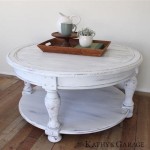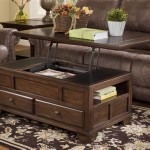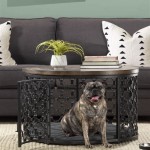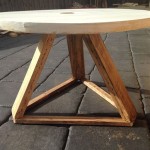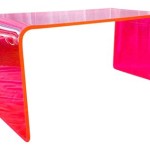How To Make A Coffee Table Out Of Pallet Wood
Creating a rustic yet stylish coffee table from reclaimed pallet wood offers a cost-effective and environmentally friendly way to furnish a living space. This project can be completed with basic woodworking tools and a moderate level of DIY experience.
Gathering Materials and Tools: The first step involves acquiring the necessary materials and tools. One or two standard-sized pallets, depending on the desired table dimensions, will be required. Ensure the pallets are heat-treated (HT) and not chemically treated (MB), as HT pallets are safer for indoor use. Additional materials include wood screws, wood glue, sandpaper (various grits), wood stain or paint (optional), a sealant or varnish, and caster wheels (optional). Essential tools include a safety mask, safety glasses, work gloves, a pry bar, a hammer, a reciprocating saw or circular saw, a measuring tape, a pencil, a drill with appropriate drill bits, a Kreg Jig (optional but recommended), and clamps.
Disassembling the Pallets: Dismantling the pallets requires careful execution to minimize wood damage. Using a pry bar and hammer, gently wedge the pry bar between the pallet slats and the supporting blocks. Gradually work the pry bar along the length of the slat, applying controlled force to pry it loose. Avoid using excessive force, which can split the wood. This process may require patience, as pallet wood can be brittle or stubbornly attached. A reciprocating saw can be utilized to cut through nails if necessary, but this method increases the risk of damaging the wood.
Preparing the Wood: Once the pallet slats are removed, they need to be cleaned and prepared for assembly. Begin by removing any remaining nails or staples. A hammer and nail punch can be used for this task. Next, the wood needs to be sanded. Start with a coarser grit sandpaper (e.g., 60 or 80 grit) to remove rough patches and splinters, then progressively move to finer grits (e.g., 120, 150, and finally 220 grit) to achieve a smooth surface. Thorough sanding is crucial for both aesthetics and safety.
Building the Tabletop: The tabletop construction involves joining the prepared pallet slats. Lay the slats side-by-side, arranging them to create a visually appealing pattern. Variations in wood color and texture can add character to the finished piece. Once the arrangement is satisfactory, secure the slats together. Clamps are essential for holding the slats in place during this process. One method is to use wood glue and screws. Apply wood glue to the edges of the slats where they contact each other. Then, pre-drill pilot holes to prevent the wood from splitting. Drive screws through the pilot holes to firmly secure the slats. A Kreg Jig can be used to create pocket holes for a more concealed joinery method.
Constructing the Frame: The frame provides support and stability for the tabletop. Cut four pieces of pallet wood to the desired length for the frame sides. These pieces should be slightly shorter than the combined width of the tabletop slats to allow for overhang. Similarly, cut two pieces for the frame ends, slightly shorter than the tabletop length. Assemble the frame using the same joinery techniques employed for the tabletop – wood glue and screws, or pocket holes.
Attaching the Tabletop to the Frame: With the frame assembled, it can be attached to the tabletop. Position the tabletop upside down on a flat surface. Place the frame on top of the tabletop, aligning the edges. Secure the frame to the tabletop using wood screws, pre-drilling pilot holes to avoid splitting the wood. Ensure the screws are long enough to penetrate the frame and firmly grip the tabletop.
Adding Finishing Touches: Once the table is assembled, apply the desired finish. This might include staining the wood to enhance its natural color, painting it for a more contemporary look, or simply applying a clear sealant or varnish to protect the wood and enhance its durability. If caster wheels are desired, they can be attached to the bottom of the frame using screws. Ensure the casters are rated for the weight of the table and its intended contents. Allow ample drying time for any applied finishes before using the coffee table.
Safety Precautions: Throughout the entire process, prioritize safety. Always wear appropriate safety gear, including safety glasses, a dust mask, and work gloves. Exercise caution when using power tools and follow manufacturer instructions. Work in a well-ventilated area when using stains, paints, or sealants.
Building a coffee table from pallet wood presents a rewarding opportunity to create a unique piece of furniture while repurposing readily available materials. The versatility of pallet wood allows for customization in terms of size, shape, and finish, offering endless possibilities to match individual style and décor.

Diy Pallet Wood Coffee Table

Diy Pallet Coffee Table No Power Tools

38 Adorable Pallet Coffee Table Plans Ideas Projects Furniture Wooden Wood

The 62 Most Creative Pallet Coffee Tables For Your Inspiration 1001 Pallets Rustic Furniture Projects

How To Create A Pallet Coffee Table In One Afternoon Eye On Design

Diy Pallet Wood Coffee Table

How To Make A Pallet Coffee Table Design Build

Diy Pallet Coffee Table Gets An Outdoor Makeover Southern Revivals

Diy Rustic Pallet Coffee Table Wonder Forest

Upcycled Diy Pallet Coffee Table Bring On The Cocktails Home Fixated
Related Posts

